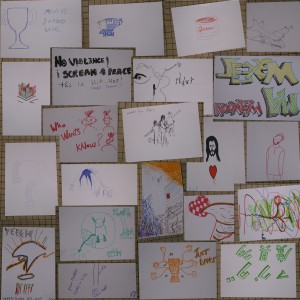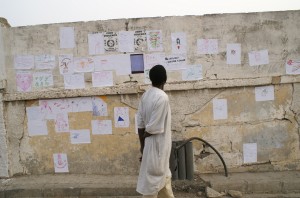Already since some time I’m very interested in graffiti and street art scene, however not so much for the sake of their art production and artistic value but this what intrigue me the most is the approach towards public space. I wonder how is the image approaching space, and how people are approaching images in certain space and how are people approaching space with images. The meaning of an image constantly circulates in the inseparable triangle of human-body-image, changes and builds multilayers variation of itself in the eye of beholder.
As in Dakar every graffiti is deeply rooted in social-political content and comes out in and from special social needs, I was particular looking for walls which was made during this election 2012. Mamadou said that we should go to see cemetery wall in Median, where some important graffiti was made in the time of demonstrations.
When we reached the cemetery I was really touched by the contrast between beautiful wide spread colorful graffiti made by the most important gaffers from Dakar and visiting artist from around the world, and small appealing images of prophets drawn with crayon or carved in the wall by passers-by. Just before I was meant to do the photo of the graffiti I came there for, the battery of my camera went off. So there is no image of this particular wall. I was very frustrated about it, because with such tight schedule I knew it will be really impossible to do a proper documentation of this wall some other time before our departure.
Later on however I thought it is not so important that I have this image. I already have it in my memory. Images are never what they claims to be. Important is the meaning and I’ve already known the meaning, and meaning it is not something which comes, we rather built it. Hence merely by looking we are activating meanings, what is the most crucial mechanism in the context of every image which appears in a public space. Every image is just a trigger for your imagination, it is a platform where you project upon your individual set of personal meanings and associations. I try to describe the moment of flux between absence and presence of the ‘real’ image and how this ambiguity is represented. This can be realised as a double nature, at first originating with an absence, which from the beginning needs to be identified with some image, and which subsequently can then be called presence. Conversely it also starts with some surpassing presence, which (with the help of some image) needs to be represented as absence, if any other images are meant to appear.
To replace this particular absence I ask people gathered in Row Material Company on the 14th of May on “Work In Progress” presentation to fill up with their images this ‘absence’ evoked by the lack of that certain photo. From their singular images made for me I wanted to create a collective image of that particular moment we was then, which later on I wanted to put again in the public space and let it grow with its own meanings.
The next day I went back to the wall of the Medina cemetery. I picked my own space and started to place in the images collected the day before. People passing by curious in what I was doing, stopped and intrigued by the action wanted to join and draw their own images. There was not even a quarter when I was surrounded by a group of people. Language came out not to be so much problem, because in this moment we were communicating with drawings. The wall started to be a space for people to spontaneously expressed themselves and share with me, and the others, important for them memories.
So the next day I left, but on the wall of the Medina cemetery since then there is a new image. It remains in this public space as an image of collectively exchanged subjectivities. At this wall people decides to share with each others their set of personal meanings and associations. Since then, this wall will grow with its own meanings. However we can no longer say ‘…nothing happened behind this wall’.






[...] are being carefully observed and controlled. Drawing on graffiti and the street art scene the Absence/Presence focuses on images in regard to memory. Magda Mellin joined in with local gaffers to create public [...]